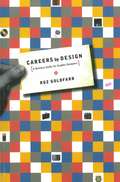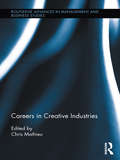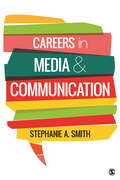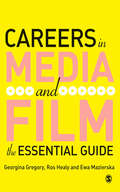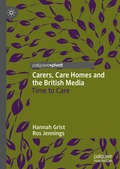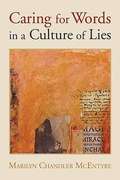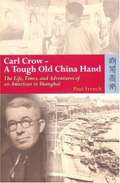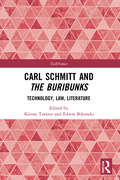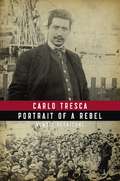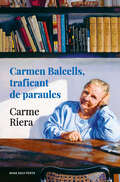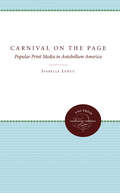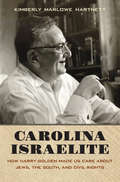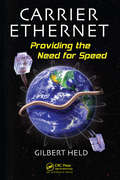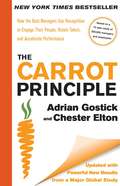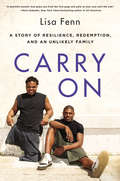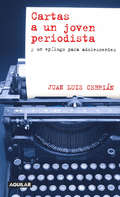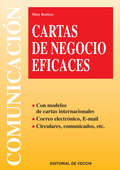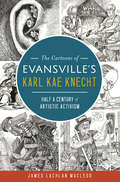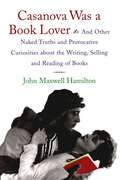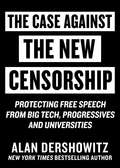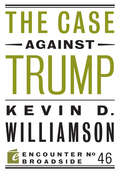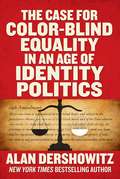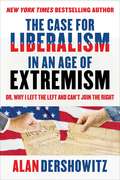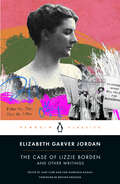- Table View
- List View
Careers by Design: A Business Guide for Graphic Designers
by Roz GoldfarbThrough her work with hundreds of corporations around the world, leading headhunter Roz Goldfarb provides readers a treasure trove of valuable information for thriving in this creatively driven business, including updated hiring criteria, the latest developments in technology, and the marketplace affecting design careers.Discussion in this revised and expanded third edition includes: jobs, hiring practices, salaries, portfolios, resumes, networking, headhunters, training, freelancing, and more, with a special focus on the new design disciplines, training requirements, and opportunities for the Internet. Careers by Design should be on the desk of every ambitious graphic designer.
Careers in Creative Industries (Routledge Advances in Management and Business Studies)
by Chris MathieuComprising original empirical studies of career-making in the creative sector, this book takes in theatre, music, film, TV, visual arts, fashion design, and architecture as creative industries. This format facilitates comparative analysis of central features of career-making within as well as across both specific industries and national contexts. The book is at the forefront and intersection of contemporary career research and research on work in creative industries / the cultural economy, intertwining both subjective and objective approaches to and dimensions of career. The contributors move beyond the dichotomies that have characterized recent career theory and work on creative industries to examine factors that facilitate and restrict horizontal and vertical mobility. Spanning a diverse range of case studies, from German theatre to Danish fashion, this book is a valuable reference for scholars of the creative and cultural industries and important reading for thoser interested in careers more generally.
Careers in Media and Communication
by Stephanie A. SmithCareers in Media and Communication is a practical resource that helps students understand how a communication degree prepares them for a range of fulfilling careers; it gives students the skills they will need to compete in a changing job market. Award-winning teacher and author Stephanie A. Smith draws from her years of professional experience to guide students through the trends and processes of identifying, finding, and securing a job in in mass communication. Throughout the book, students explore the daily lives of professionals currently working in the field, as well as gain firsthand insights into the training and experience that hiring managers seek.
Careers in Media and Communication
by Stephanie A. SmithCareers in Media and Communication is a practical resource that helps students understand how a communication degree prepares them for a range of fulfilling careers; it gives students the skills they will need to compete in a changing job market. Award-winning teacher and author Stephanie A. Smith draws from her years of professional experience to guide students through the trends and processes of identifying, finding, and securing a job in in mass communication. Throughout the book, students explore the daily lives of professionals currently working in the field, as well as gain firsthand insights into the training and experience that hiring managers seek.
Careers in Media and Film: The Essential Guide
by Georgina Gregory Ewa Mazierksa Ros J HealyWritten for students, graduates and academics from the disciplines of film, media and related subjects, and for those from other disciplines who want to break into the media, this book is a virtual career coach and an employability course all in one package. A practical handbook, it offers encouragement, advice, information and case studies to help students to make the most of the opportunities in this very competitive career world. The book can be used as a textual support for careers modules and PDP (Personal Development Planning), graduate workshops, on-line courses and as a departmental or careers library resource. Equally, it works effectively as a self-help guide to enable individuals to focus on their career / life development.
Carers, Care Homes and the British Media: Time to Care
by Hannah Grist Ros JenningsThis book focuses on the relationship between the media and those who work as paid care assistants in care homes in Britain. It explores this relationship in terms of the contemporary cultural and personal understandings of care work and care homes that have developed as the role has emerged as increasingly socially and economically significant in society. Three strands of analysis are integrated: an examination of the representations of paid care workers in the British media; the experiences of current and former care workers; and the autoethnographic reflections of the authors who have experiences of working as care assistants. The book offers a rich contextual and experiential account of the responsibilities, challenges, and emotions of care work in British society. Grist and Jennings make a case for the need to better value and more accurately represent care work in contemporary media accounts.
Caring for Words in a Culture of Lies
by Marilyn Chandler McentyreLike any other life-sustaining resource, says Marilyn Chandler McEntyre, language can be depleted, polluted, contaminated, eroded, and filled with artificial stimulants. Today more than ever, language needs to be rescued and restored. Drawing on a wide range of sources, both critical and literary, Caring for Words in a Culture of Lies is an engaging address to everyone concerned with preserving the vitality and precision of the spoken and written word. / If every literate person in the United States read this book, the result could dramatically transform our society. . . . Written with modesty, keen insight, and grace, Marilyn Chandler McEntyre's Caring for Words in a Culture of Lies proposes a revolution of human expression that would bring precision, honesty, and felicity to the spoken and written discourse of contemporary culture. This is a book to read and pass on with the fervent hope that its truth may spread and endure. Emory Elliott / Director of the Center for Ideas and Society / University of California, Riverside / McEntyre's prose is lyrical, at times luminous. . . . Her thoughtful analyses of the written word invite all of us to read more deeply, and her discussion of how readers enter a text leads us to examine the architectural structure of our own work. Kathryn Reiss / Mills College author of Time Windows, PaperQuake, and Blackthorn Winter"
Carl Crow - A Tough Old China Hand
by Paul FrenchCarl Crow arrived in Shanghai in 1911 and made the city his home for the next quarter of a century, working there as a journalist, newspaper proprietor, and groundbreaking adman. He also did stints as a hostage negotiator, emergency police sergeant, gentleman farmer, go-between for the American government, and propagandist. As his career progressed, so did the fortunes of Shanghai. The city transformed itself from a dull colonial backwater when Crow arrived, to the thriving and ruthless cosmopolitan metropolis of the 1930s when Crow wrote his pioneering book - 400 Million Customers - that encouraged a flood of businesses into the China market in an intriguing foreshadowing of today's boom. Among Crow's exploits were attending the negotiations in Peking that led to the fall of the Qing Dynasty, getting a scoop on Japanese interference in China during the First World War, negotiating the release of a group of Western hostages from a mountain bandit lair, and being one of the first Westerners to journey up the Burma Road during the Second World War. He met most of the major figures of the time, including Sun Yat-sen, Chiang Kai-shek, the Soong sisters, and Mao's second-in-command Zhou En-lai. During the Second World War, he worked for American intelligence alongside Owen Lattimore, coordinating US policies to support China against Japan. The story of this one exceptional man gives us a rich view of Shanghai and China during those tempestuous years. This is a book for all with an interest in Shanghai and China of this period, and those with an interest in the development of journalism and business there.
Carl Schmitt and The Buribunks: Technology, Law, Literature (TechNomos)
by Kieran TranterIn 1918 a young Carl Schmitt published a short satirical fiction entitled The Buribunks. He imagined a future society of beings who consistently wrote and disseminated their personal diaries. Schmitt would go on to become the infamous philosopher of the exception and for a while the ‘Crown Jurist of the Third Reich’. The Buribunks – ironically for beings that lived only for self-memorialisation – has been mostly lost to history. However, the digital realm, with its emphasis on the informatic traces generated by human doing, and the continual interest in Schmitt’s work to explain and criticise contemporary constellations of power, suggests that The Buribunks is a text whose epoch has come. This volume includes the first full translation into English of The Buribunks and a selection of critical essays on the text, its meanings in the digital present, its playing with and criticism of the literary form, and its place within Schmitt’s life and work. The Buribunks and the essays provide a complex, critical and provocative invitation to reimagine the relations between the human and their imprint and legacy within archives and repositories. There is a fundamental exploration of what it means to be a being intensely aware of ‘writing itself’. This is not just a volume for critical lawyers, literary scholars and the Schmitt literati. It is a volume that challenges a broad range of disciplines, from philosophy to critical data studies, to reflect on the digital present and its assembled and curated beings. It is a volume that provides a set of fantastically located concepts, images and histories that traverse ideas and practices, play and politics, power and possibility.
Carlo Tresca
by Nunzio PerniconeNunzio Pernicone's biography uses Carlo Tresca's (1879-1943) storied life?as newspaper editor, labor agitator, anarchist, anti-communist, street fighter, and opponent of fascism?as a springboard to investigate Italian immigrant and radical communities in the United States. From his work on behalf of the Industrial Workers of the World (IWW), the Sacco and Vanzetti Defense Committee, and his assassination on the streets of New York City, Tresca's passion left a permanent mark on the American map. This edition, both revised and expanded, provides new insight into the American labor movement and a unique perspective on the immigrant experience.
Carmen Balcells, traficant de paraules
by Carme RieraLa primera biografia autoritzada de Carmen Balcells, l'agent literària que va revolucionar el panorama literari en llengua espanyola. Carmen Balcells va ser molt més que una agent, va ser un mite. Una combinació afortunada de talent, intel·ligència i ambició la va convertir en un referent internacional de la literatura en llengua espanyola. A l'hora d'escriure'n la biografia, Carme Riera, la qual va tractar amb ella durant gairebé quaranta anys, ha tingut accés a l'arxiu de l'Agència i ha entrevistat familiars, amics, autors, editors i agents. El resultat és el retrat esplèndid d'una figura estimada i temuda, poderosa i polèmica, que va reunir un catàleg insòlit d'autors i ocupa un lloc essencial en la cultura hispànica dels últims setanta anys. Ressenyes:«Carmen Balcells és un emperador romà.»Gonzalo Suárez «Tenir a Balcells era viatjar sempre en primera classe.»Eduardo Mendoza «Amb Balcells hi va guanyar sempre la literatura.»Miquel de Palol «El llegat de Balcells no és menys important que el que deixa un gran escriptor, pintor o músic.»Mario Vargas Llosa
Carnival on the Page: Popular Print Media in Antebellum America
by Isabelle LehuuIn the decades before the Civil War, American society witnessed the emergence of a new form of print culture, as penny papers, mammoth weeklies, giftbooks, fashion magazines, and other ephemeral printed materials brought exuberance and theatricality to public culture and made the practice of reading more controversial. For a short yet pivotal period, argues Isabelle Lehuu, the world of print was turned upside down. Unlike the printed works of the eighteenth century, produced to educate and refine, the new media aimed to entertain a widening yet diversified public of men and women. As they gained popularity among American readers, these new print forms provoked fierce reactions from cultural arbiters who considered them transgressive. No longer the manly art of intellectual pursuit, reading took on new meaning; reading for pleasure became an act with the power to silently disrupt the social order.Neither just an epilogue to an earlier age of scarce books and genteel culture nor merely a prologue to the late nineteenth century and its mass culture and commercial literature, the antebellum era marked a significant passage in the history of books and reading in the United States, Lehuu argues.Originally published 2000.A UNC Press Enduring Edition -- UNC Press Enduring Editions use the latest in digital technology to make available again books from our distinguished backlist that were previously out of print. These editions are published unaltered from the original, and are presented in affordable paperback formats, bringing readers both historical and cultural value.
Carolina Israelite: How Harry Golden Made Us Care about Jews, the South, and Civil Rights
by Kimberly Marlowe HartnettThis first comprehensive biography of Jewish American writer and humorist Harry Golden (1903-1981)--author of the 1958 national best-seller Only in America--illuminates a remarkable life intertwined with the rise of the civil rights movement, Jewish popular culture, and the sometimes precarious position of Jews in the South and across America during the 1950s.After recounting Golden's childhood on New York's Lower East Side, Kimberly Marlowe Hartnett points to his stint in prison as a young man, after a widely publicized conviction for investment fraud during the Great Depression, as the root of his empathy for the underdog in any story. During World War II, the cigar-smoking, bourbon-loving raconteur landed in Charlotte, North Carolina, and founded the Carolina Israelite newspaper, which was published into the 1960s. Golden's writings on race relations and equal rights attracted a huge popular readership. Golden used his celebrity to editorialize for civil rights as the momentous story unfolded. He charmed his way into friendships and lively correspondence with Carl Sandburg, Adlai Stevenson, Robert Kennedy, and Billy Graham, among other notable Americans, and he appeared on the Tonight Show as well as other national television programs. Hartnett's spirited chronicle captures Golden's message of social inclusion for a new audience today.
Carrier Ethernet: Providing the Need for Speed
by Gilbert HeldFacilitating high data transfers over long distances at a reasonable cost, Carrier Ethernet is solidifying its fundamental position as the core of next-generation networks. Since it first dazzled the IT world 40 years ago with its ability to move data over local networks, Ethernet has dramatically evolved in both form and function. And now, Carrier
The Carrot Principle: How the Best Managers Use Recognition to Engage Their Employees, Retain Talent, and Drive Performance
by Adrian Gostick Chester EltonSince its original publication in 2007, the New York Times bestseller The Carrot Principle has received rave reviews in The Wall Street Journal, Fortune, and The New York Times, and has helped a host of managers to energize their teams and companies to dramatically boost their business results. The book was even adopted by the prestigious Franklin Covey International training and consulting group for its leadership training. This updated edition couldn't come at a better time, as the economic downturn requires us all to come up with creative and cost-effective ways to stimulate growth and productivity.
Carry On: A Story of Resilience, Redemption, and an Unlikely Family
by Lisa Fenn“An incredible life-affirming story” about an unexpected, lifechanging relationship between an ESPN producer and two disabled, inner-city athletes (Family Circle). When award-winning ESPN producer Lisa Fenn returned to her hometown for a story about two wrestlers at one of Cleveland’s toughest public high schools, she had no idea that the trip would change her life. Both young men were disadvantaged students with significant physical disabilities. Dartanyon Crockett was legally blind as a result of Leber’s disease; Leroy Sutton lost both his legs at eleven, when he was run over by a train. Brought together by wrestling, they had developed a brother-like bond as they worked to overcome their disabilities.After forming a profound connection with Dartanyon and Leroy, Fenn realized she couldn't just walk away when filming ended; these boys had had to overcome the odds too many times. Instead, Fenn dedicated herself to ensuring their success long after the reporting was finished and the story aired—and an unlikely family of three was formed.The years ahead would be fraught with complex challenges, but Fenn stayed with the boys every step of the way—teaching them essential life skills, helping them heal old wounds and traumatic pasts, and providing the first steady and consistent support system they’d ever had.This powerful memoir is one of love, hope, faith, and strength—a story about an unusual family and the courage to carry on, even in the most extraordinary circumstances.“A poignant memoir.” —Sports Illustrated“A profoundly moving memoir about two boys who become men in the face of life’s toughest challenges:. We see the many ways in which one person can carry another, and we are inspired to do the same.” —Tim Howard, New York Times–bestselling author of The Keeper“‘An astonishingly beautiful tale . . . like The Blind Side or Same Kind of Different As Me, Lisa Fenn’s work forces us to reframe our definition of family.” —Kevin Salwen, author of The Power of Half“A heartfelt memoir that grips you from the first page and pulls at your soul until the end” —Steve Eubanks, New York Times–bestselling author of All American
Cartas a un joven periodista: y un epílogo para adolescentes
by Juan Luis CebriánEstas cartas a Honorio, un joven periodista o, mejor aún, aspirante a serlo, constituyen un pequeño legado de reflexión y dudas de uno de los profesionales más conocidos de nuestro país. A través de estas misivas, el autor debate con su destinatario algunas de las cuestiones básicas sobre el ejercicio del periodismo y la importancia de los medios de comunicación. Escrito en un lenguaje directo, coloquial y muy inteligible, Cartas a un joven periodista (completadas en esta edición con un «epílogo para adolescentes») no está dirigido en realidad sólo a los jóvenes, ni mucho menos sólo a los periodistas, sino a todo aquel preocupado por los perfiles de esta sociedad mediática que nos ha tocado vivir. Lejos de constituir un conjunto de lecciones es, más bien, una narración de experiencias que nos conduce a una meditación sobre aspectos tan importantes como controvertidos de las modernas democracias.
Cartas de negocio eficaces
by Mary Bosticco* Escribir cartas de negocio es una tarea que exige mucho tiempo y requiere un buen conocimiento de los modelos de redacción y los recursos expresivos, ya que se debe ser siempre claro, breve y eficaz, teniendo en cuenta las circunstancias y el destinatario. * Este manual le ofrece cuanto debe saber acerca del correo comercial, a fin de que pueda mejorar la calidad de sus cartas --tanto en español como en inglés--, sin tener que dedicarles demasiado tiempo. * En sus páginas encontrará las fórmulas de cortesía más comunes, las normas de puntuación, las expresiones que deben evitarse, los encabezamientos y membretes, la disposición de cada una de las partes, el papel y los sobres que han de utilizarse, los formatos más adecuados, etc. * Además, usted encontrará casi 700 ejemplos de cartas comerciales redactadas en los más diversos estilos. Tan sólo hay que escoger el más conveniente y adaptarlo a las propias necesidades. Mary Bosticco es una escritora especializada en el mundo empresarial. Ha sido consultora, periodista, relaciones públicas y ha escrito numerosos libros dedicados a la dirección de empresas que han tenido siempre una buena aceptación.
The Cartoons of Evansville's Karl Kae Knecht: Half a Century of Artistic Activism
by James Lachlan MacleodKarl Kae Knecht’s name is synonymous with the city of Evansville. As editorial cartoonist for the Evansville Courier, he amused readers and spurred them to a higher social good. He mocked the Axis powers and kept local morale high during World War II and commented daily on issues from the Great Depression to the Space Race. He also worked tirelessly as a civic booster. Knecht helped establish Evansville College and was almost single-handedly responsible for the establishment of Mesker Park Zoo. In this absorbing account, illustrated with over seventy cartoons, University of Evansville historian James Lachlan MacLeod tells the fascinating story of Knecht’s life and analyzes his cartooning genius.
Casanova Was A Book Lover: And Other Naked Truths and Provocative Curiosities about the Writing, Selling, and Reading of Books
by John Maxwell HamiltonEveryone knows which books people buy; they can just look at the best-seller lists. But who knows which books people steal? Who, for that matter, knows that authors ruin the book market by writing too much? Or why book critics are not critical? Or why librarians need to throw out more books? Who, indeed, knows the answer to that all-important question in our democracy: should presidents and presidential candidates write books? (The answer is no.)In this irreverent analysis of the book industry, John Maxwell Hamilton -- a longtime journalist and public radio commentator -- answers these questions and many more, proving that the best way to study books is not to take them too seriously. He provides a rich history of the book -- from the days when monks laboriously hand-copied texts to the tidal wave of Titanic tie-ins -- and gives a succinct overview of the state of the industry today, including writing, marketing, promoting, reviewing, ghostwriting, and collecting.Throughout, Hamilton peppers his prose with spicy tidbits of information that will fascinate bibliophiles everywhere. For instance, did you know that Walt Whitman was fired from a government job because his boss found Leaves of Grass, and its author, immoral? Or that the most stolen book in the United States is the Bible, followed by The Joy of Sex? How about that Dan Quayle's 1989 Christmas card read, "May our nation continue to be a beakon of hope to the world"? Or that Casanova was an ardent lover of books as well as women?Hamilton offers an inside look at the history and business of book reviewing, explaining why, more often than not, reviewers resemble "counselors at a self-esteem camp" and examining the enormous impact of the "Oprah effect" on the market. As the self-appointed Emily Post of the book world, he advises publishers, authors, and readers on proper etiquette for everything from book parties ("Feel free to build a party around a theme in a book, no matter how tacky") and jacket photos ("You should not show off your new baby unless [your] book [is] about raising kids"), to book signings ("Just because an author has given you an autograph does not mean they want to become your pen pal") and promotion by friends and relatives ("They should carry the book at all times on public transportation with the cover showing").Both edifying and enjoyable, Casanova Was a Book Lover fills a Grand Canyon--sized void in the literature on literature. It is indispensable for book enthusiasts who want to know the naked truth about reading, writing, and publishing.
Case Against the New Censorship: Protecting Free Speech from Big Tech, Progressives, and Universities
by Alan DershowitzIn The Case Against the New Censorship: Protecting Free Speech from Big Tech, Progressives, and Universities, Alan Dershowitz—New York Times bestselling author and one of America&’s most respected legal scholars—analyzes the current regressive war against freedom of speech being waged by well-meaning but dangerous censors and proposes steps that can be taken to defend, reclaim, and strengthen freedom of speech and other basic liberties that are under attack. Alan Dershowitz has been called &“one of the most prominent and consistent defenders of civil liberties in America&” by Politico and &“the nation&’s most peripatetic civil liberties lawyer and one of its most distinguished defenders of individual rights&” by Newsweek. He is also a fair-minded and even-handed expert on the Constitution and our civil liberties, and in this book offers his knowledge and insight to help readers understand the war being waged against free speech by the ostensibly well-meaning forces seeking to constrain this basic right. The Case Against the New Censorship is an analysis of every aspect of the current fight against freedom of speech, from the cancellations and deplatformings practiced by so-called progressives, to the powerful, seemingly arbitrary control exerted by Big Tech and social media companies, to the stifling of debate and controversial thinking at public and private universities. It assesses the role of the Trump presidency in energizing this backlash against basic liberties and puts it into a broader historical context as it examines how anti-Trump zealots weaponized, distorted, and weakened constitutional protections in an effort to &“get&” Trump by any means. In the end, The Case Against the New Censorship represents an icon in American law and politics exploring the current rapidly changing attitudes toward the value of free speech and assessing potential ways to preserve our civil liberties. It is essential reading for anyone interested in or concerned about freedom of speech and the efforts to constrain it, the possible effects this could have on our society, and the significance of both freedom of speech and the battle against it in a greater historical and political context.
The Case Against Trump
by Kevin D. WilliamsonDonald Trump, who rocketed to the top of the polls in the early GOP primary race, is an unlikely Republican front-runner: a longtime supporter of Democratic politicians with a history of taking views opposed to those of mainstream conservatives. A household name for his reality-television show and his tawdry tabloid history, he has connected with an underappreciated strain of right-wing populists by focusing his fire on a single issue: immigration.In this Broadside, Kevin D. Williamson takes a hard look at the Trump phenomenon and the failures of the national Republican leadership - and defects in our national character - that gave it life. Trump may or may not be in the race for the long haul, but in either case, Trumpism will remain a force.
The Case for Color-Blind Equality in an Age of Identity Politics
by Alan DershowitzIn The Case for Color-Blind Equality in an Age of Identity Politics, Alan Dershowitz—New York Times bestselling author and one of America&’s most respected legal scholars—analyzes the current battles over issues of diversity and our rapidly changing ideas about what true diversity is. Alan Dershowitz has been called &“one of the most prominent and consistent defenders of civil liberties in America&” by Politico and &“the nation&’s most peripatetic civil liberties lawyer and one of its most distinguished defenders of individual rights&” by Newsweek. He is also a fair-minded and even-handed expert on civil liberties and constitutional rights, and in this book offers his knowledge and insight to help readers understand the war being waged against meritocracy and equal protection of the law by so-called progressive advocates. The Case for Color-Blind Equality in an Age of Identity Politics is an analysis of every aspect of the current fight against true diversity—diversity of philosophy, background, and opinion, rather than the more surface-level diversity of race, religion, and location. It examines the United States&’s history of systemic racism, debates about affirmative action, and ongoing reckoning with issues of bigotry against groups such as Asians, Blacks, and Jews, with an eye toward fairly balancing the concerns of a diverse populace. In the end, The Case for Color-Blind Equality in an Age of Identity Politics represents an icon in American law and politics exploring the current rapidly changing attitudes toward meritocracy, personal identity, and the preservation of civil liberties for all citizens, regardless of background, race, class, or creed. It is essential reading for anyone interested in or concerned about identity politics, racial issues, and true diversity and fairness in America.
The Case for Liberalism in an Age of Extremism: or, Why I Left the Left But Can't Join the Right
by Alan Dershowitz&“Maybe the question isn&’t what happened to Alan Dershowitz. Maybe it&’s what happened to everyone else.&”—PoliticoIn The Case for Liberalism in an Age of Extremism, Alan Dershowitz—New York Times bestselling author and one of America&’s most respected legal scholars—makes a classical liberal argument for centrist government in the US, as the Founding Fathers and the Constitution intended. Alan Dershowitz has been called &“one of the most prominent and consistent defenders of civil liberties in America&” by Politico and &“the nation&’s most peripatetic civil liberties lawyer and one of its most distinguished defenders of individual rights&” by Newsweek. Yet he has come under intense criticism for his consistent classical liberalism in the face of a rapidly polarizing political landscape and for his steadfast support of centrist governance over either &“progressive&” or reactionary radicalism. The Case for Liberalism in an Age of Extremism is a defense of liberalism and its renewed relevance today. It makes the case for classic liberal values and programs over radical-left and reactionary right-wing agendas, and for centrism over extremism in general, showing why the United States has thrived throughout history because of its enduringly centrist base. It seeks to restore contemporary liberalism to its important place in the American political landscape, and attempts to persuade centrists from both the left and right—who may today call themselves progressives or moderate conservatives—that they, too, belong in the big tent of centrist liberalism. As a professor for half a century, Dershowitz never told students what values to accept or which candidates to support, but helped guide them to conclusions based on their own sets of values. He does the same in this book. A guide for all readers, rather than a piece of political advocacy for one party or another, The Case for Liberalism in an Age of Extremism is Alan Dershowitz&’s argument for classical liberal values and their role in forming just societies and protecting against the dangers of extremism, just as they must today. It is essential reading for anyone interested in or concerned about political polarization on both the far-right and -left, and for everyone seeking a middle path between the extremes.
The Case of Lizzie Borden and Other Writings: Tales of a Newspaper Woman
by Elizabeth Garver JordanThe first and only comprehensive collection of writings by Elizabeth Garver Jordan, the groundbreaking journalist, suffragist, and editor whose fearless reporting on women preceded the #MeToo movement and popularized the true-crime genreA Penguin ClassicThe Case of Lizzie Borden and Other Writings is the first to collect Garver Jordan&’s fiction and journalism, much of which has been out of print for over a century. Jordan began her career as a reporter, making her name as one of few women journalists to cover the Lizzie Borden murder trial for the New York World in 1893. Jordan&’s distinctive, narrative-driven coverage of the Borden and other high-profile murder cases brought her national visibility, and she turned increasingly to fiction writing. Drawing on her experiences as a true-crime reporter and newspaper editor, she published detective novels and short story collections such as Tales of the City Room that explored the fine line between women&’s criminality and crimes against women. Employing popular genre conventions as a means of dealing with women&’s issues, Jordan exposed gendered abuse in the workplace and the prevalence of sexual violence. The Case of Lizzie Borden and Other Writings encourages readers to draw a historical trajectory from Jordan&’s pioneering literary activism to the writings of contemporary journalists and novelists whose work continues to fuel discussions of gender, feminism, and crime, raising questions about who gets to tell women&’s stories, especially in the wake of the #MeToo movement.
